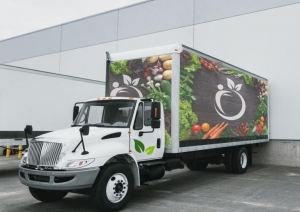
With summer upon us, many wholesale distributors are in their busiest season — especially those in food and beverage distribution.
Spring marks beginning of produce season, where the surplus of fresh fruits and vegetables that need to be quickly transported take precedence over other, less profitable freight. Summer calls for more orders of soda, food for barbecues, and alcoholic beverages.
What can your company do to not just survive, but thrive, during this busy time?
Invest in real-time tracking technology
With last-mile delivery, the right technology can be a game changer.
The last mile is such a challenging leg of logistics and works on such tight schedules that knowing where your drivers — and your deliveries — are at any given minute can mean the difference between a day of on-time deliveries versus a day of deliveries that become delayed by more and more time as the hours progress.
Omnitracs’ Roadnet Anywhere, for example, allows fleet managers to easily import orders, route vehicles (while factoring in business constraints like time windows), execute same-day changes to assigned stops and stop sequence, send messages to drivers, and track drivers in real time.
On the driver side, drivers can access mobile trip management, proof of delivery tools, and messaging through the Roadnet Anywhere Mobile application — ensuring that changes and adjustments to the route can be made as needed, and that communication to the back office stays open throughout the day.
Build in more accurate time estimates to ensure deliveries are on time, even on the busiest days
Consumers are becoming more and more demanding when it comes to deliveries — purchasing smaller quantities and desiring them more quickly. Most expect a delivery within two days at the most, with one day or same day being ideal. This consumer trend is bleeding into the B2B world, with many customers expecting the same experience from their distributors as they do outside of work.
Retailers are increasingly asking for smaller and more frequent deliveries. For distributors, smaller drop size and more frequent deliveries are a recipe that can quickly eat away at profits.
Instead of being able to group orders together geographically by day and sequencing them in the most optimal way each day, distributors often have to return to the same area they were just in the day before or backtrack to an area they just left earlier that day.
It can be tempting to cave in to this pressure and promise overly ambitious delivery times. However, if you don’t account for the proper amount of time, you’ll find yourself with lots of angry customers when something like inclement weather or a bad traffic jam sets one of your drivers back.
Within Omnitracs Roadnet Anywhere routing, you can set the fixed service time per stop, to include various delays such as waiting for docks and elevator wait times, and you can also set a planned variable service time per unit being handled, to more accurately account for time fluctuations driven by increases or decreases from volume. Once you have some actual service time information from historical stops, you can run Service Time Analyzer. This tool analyzes the actual service times to recommend and adjust the planned fixed service time per stop and variable service time per unit — which account for the various delays drivers typically encounter, minimizing the chance of unplanned work hours by accurately estimating total route/trip time.
Drive time is a large part of every driver’s day. Roadnet Anywhere leverages historical traffic to determine the best time to start a route/trip. It accounts for how much traffic is anticipated as the route progresses to each stop throughout the day, in order to minimize the total amount of traffic encountered. This minimizes the chance of unplanned work hours by accurately estimating total route/trip time.
These predictions are incorporated into an evolutionary genetic algorithm, a type of Artificial Intelligence (AI), which utilizes techniques like mutation and recombination, to determine the best stop assignment across multiple routes, and the most efficient and effective stop sequence within a route — to minimize mileage and drive time, while still meeting customer delivery windows.
Your company almost certainly has huge volumes of data sitting unused; Put it to work through analysis
Every company collects a wide variety of data. There’s sales data, price data, delivery data — the list continues. More often than not, this data is collected, glanced at, and then sent to a folder or file on your company server where it sits unused.
Data collected from your routing and dispatching technology can be a goldmine for your company, helping you make operational decisions. Planned versus Actual (PvA) reporting, for example, shows you whether your company’s carefully-planned deliveries followed schedule or not, and where inefficiencies may lie.
Through a business intelligence tool, managers can get a visual representation of data, showing trends such as drivers who idle frequently, missed time windows to your customers, and more. Each business requires different key performance indicators (KPIs) and with a tool like Omnitracs Roadnet Insight, you can create dashboards for things like average cost per mile, average cost per stop, etc.
Being able to dig deeper into trends and outliers is key. Insight enables customers to view data historically by business unit or region, and quickly click to drill down on KPIs to find the root cause of how transportation decisions affect their bottom line.
As delivery picks up during the warmer months, distributors need all the tools they can get to ensure that customers get their orders delivered quickly and accurately. To learn more about how Omnitracs’ software solutions can help, visit our planning and delivery solutions page.
